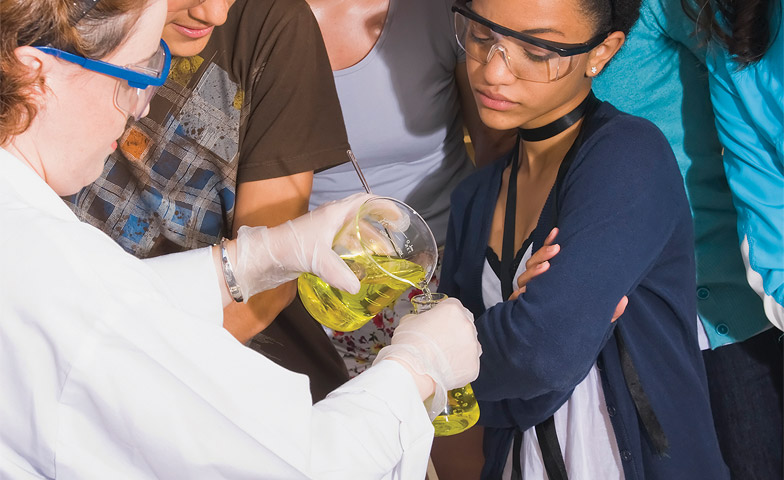Even the most technical STEM jobs require verbal and written communication skills.
Engler pointed out the United States’ reliance on more qualified workers to fill the increased number of jobs in the science, technology, engineering, and mathematics fields, or STEM. “We need STEM-related talent to compete globally, and we will need even more in the future. It is not a matter of choice: For the United States to remain the global innovation leader, we must make the most of all of the potential STEM talent this country has to offer,” Engler said.
While students are being encouraged to explore the STEM field, it would be unfortunate if the humanities fields and skills were deemed to be less important. It is precisely skills like effective written and oral communication, written expression, and interpersonal skills that can make a qualified STEM candidate stand out from the crowd.
According to the U.S. Department of Commerce Economics and Statistics Administration report, STEM: Good Jobs Now and for the Future, STEM jobs are projected to grow at a rate of 18% from 2008 to 2018, compared to 9.8% for non-STEM occupations. The job force needs prepared college graduates to fill these jobs, and candidates’ communication, problem-solving, and interpersonal skills they learned in the humanities are
more vital than ever.
For example, in a LinkedIn job posting for a senior software engineer search algorithms and data analytics position at The Home Depot, the first skills listed are “strong interpersonal skills, written and verbal communication” and “strong decision-making, problem-solving skills, critical thinking, and testing skills.” Clearly, even the most technical STEM jobs require verbal and written communication skills.
STEM and Beyond
Holcomb Bridge Middle School in Alpharetta, Georgia, operates a STEM Academy as a “school within a school” model. Teachers and administrators select students with high science and math scores and place them in a cohort for integrated science, math, and engineering classes. Students participate in a science fair, hear guest speakers from STEM professions, and complete a STEM portfolio with artifacts from their three STEM classes.
The STEM Academy gives high-achieving students with an interest in math and science a great place to grow their talents and gain experience in these high- demand areas.
Beyond the STEM Academy, to prepare all students to be effective communicators, the humanities department at Holcomb Bridge promotes the continuous development of our readers and writers. This year, our language arts and reading classes focused heavily on reading and analyzing technical documents. Teachers challenged students to read and use data from technical documents in their writing in order to better understand the often-difficult nonfiction texts.
Our school also implemented a writing portfolio. Students save one example of persuasive, narrative, and expository writing from throughout the year, along with the prewriting and preliminary drafts.
The portfolio travels with them from sixth to eighth grade and serves as an artifact of writing improvement for high school admissions. Students have the chance to reflect on their improvement throughout the year, as well as throughout their middle school career.
To encourage our students’ love of reading, the humanities department created a monthly book club. Teachers in all the humanities content areas (reading, English language arts, world language, and social studies) volunteer to sponsor a book club session once a month.
Teachers choose books that are high interest and do not necessarily apply to the curriculum. Students are more interested and involved when they are given the chance to work with students from different grade levels and share their thoughts on the complex plots and themes.
Finally, the eighth grade language arts teachers started a program they call Literacy 4 Life. Students follow “Lacey,” a cartoon girl posted on the classroom wall, through her life, using literacy skills to navigate complicated documents. Students scour documents such as the Georgia Driver’s Manual, a college application, and job applications. They learn the importance of being able to apply an understanding of nonfiction documents in real-life situations.
Many of our students speak English as a second language; some of their parents do not speak English at all. As such, they often are challenged to read and interpret nonfiction texts for their families. As young adolescents, they are tasked with reading, interpreting, and sometimes writing for their parents.
Understanding student and family needs makes the Literacy 4 Life initiative even more applicable and important.
Maintaining Importance
English language arts, reading, and social studies teachers: have no fear for your future in education. Although technology is rising in importance and the STEM areas are gaining in popularity, there will always be a place for the humanities.
Students still need to learn history. They need to know how to communicate effectively and they must learn strategies for deciphering difficult nonfiction texts. That is where English language arts, reading, social studies, and foreign language come in.
The humanities give students a foundation on which to attach new information and build a deeper level of knowledge.
